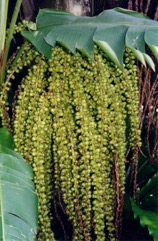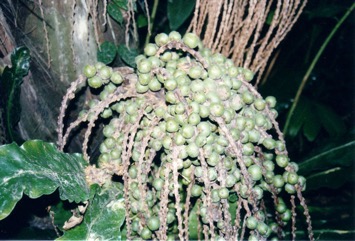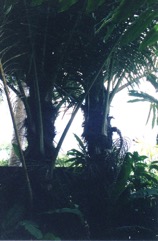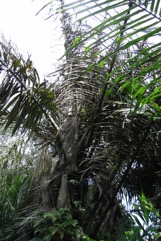Black Sugar palm

A tropical palm. It needs warmth and humidity. It grows in lowland forest up to 500 m altitude. Widely distributed at low and medium altitudes throughout the settled areas of the Philippines along streams. It grows in limestone areas. It suits hardiness zones 10-12. In the Cairns Botanical Gardens. In Yunnan. In Townsville Palmetum.
Also known as:
Anau, Aren, Bergat, Berkat, Cabo-negro, Enau, Gomuti palm, Habong, Inau, Juo, Kabong, Kaong, Kawung, Kichilippanai, Lirang, Mergat, Nanggung, Nau, Palem aren, Palem saguer, Peluluk, Sugar palm, Suikerpalm, Tali metan, Taren, Ta-shing, Taung-on, Taw-on, Thangtung
Synonyms
- Arenga gamuto (Houtt.) Merr.
- Arenga saccharifera Labill. ex DC.
- Saguerus gamuto Houtt.
- Saguerus pinnatus Wurmb
- Saguerus rumphii Roxb.
Edible Portion
- Juice - flowers, Sap, Seeds, Cabbage, Sago, Starch, Palm heart
Where does Black Sugar palm grow?
Found in: Africa, Asia, Australia, Bali, Bangladesh, Benin, Cambodia, China, East Africa, East Timor, Fiji, Guam, India, Indochina, Indonesia, Laos, Malaysia, Myanmar, Northeastern India, Pacific, Papua New Guinea, PNG, Philippines, SE Asia, Sri Lanka, Taiwan, Tanzania, Thailand, Tibet, Timor-Leste, United States, Vietnam, West Africa, West Timor
Notes: There are 17-20 Arenga species.
Growing Black Sugar palm
Cultivation: Plants are grown from seed. The seed grow easily.
Edible Uses: The bud is eaten raw or cooked. The sap is collected for vinegar etc. The fleshy kernels of the fruit are cooked and eaten. (The fruit contain calcium oxalate and are not edible) Edible starch can be extracted from the stem. The palm heart is edible. It is also used for pickles.
Production: It is fast growing and short lived. An estimated sugar yield for 150-200 trees per hectare is 10 tons of marketable sugar over 10-15 years. A tree can yield 2 litres per day for 25 days. If the growing tip or cabbage is removed the palm usually develops side shoots and remains alive.
Nutrition Info
per 100g edible portion| Edible Part | Energy (kcal) | Protein (g) | Iron (mg) | Vitamin A (ug) | Vitamin c (mg) | Zinc (mg) | % Water |
|---|---|---|---|---|---|---|---|
| Palm heart | 19 | 0.1 | 0.5 | - | - | - | 94.7 |
| Sap | 396 | - | - | - | - | - | |
| Pith starch | - | - | - | - | - | - | |
| Nuts | - | 10.03 | - | - | - | - |
Black Sugar palm Photos




References
Ali, A. M. S., 2005, Homegardens in Smallholder Farming Systems: Examples from Bangladesh. Human Ecology, Vol. 33, No. 2 pp. 245-270 (As Arenga saccharifera)
Ambasta S.P. (Ed.), 2000, The Useful Plants of India. CSIR India. p 51
Anderson, E. F., 1993, Plants and people of the Golden Triangle. Dioscorides Press. p 202
Arora, R. K., 2014, Diversity in Underutilized Plant Species - An Asia-Pacific Perspective. Bioversity International. p 100
Baker, W.J. and Dransfield, J., 2006, Field Guide to Palms of New Guinea. Kew p 54
Balick, M.J. and Beck, H.T., (Ed.), 1990, Useful palms of the World. A Synoptic Bibliography. Colombia p 99, 121 (As Arenga saccharifera), 215, 408, 542 (As Saguerus pinnatus), 659 (As Arenga saccharifera),
Bircher, A. G. & Bircher, W. H., 2000, Encyclopedia of Fruit Trees and Edible Flowering Plants in Egypt and the Subtropics. AUC Press. p 40
Blomberry, A. & Rodd, T., 1982, Palms. An informative practical guide. Angus & Robertson. p 55
Bremness, L., 1994, Herbs. Collins Eyewitness Handbooks. Harper Collins. p 38
Brickell, C. (Ed.), 1999, The Royal Horticultural Society A-Z Encyclopedia of Garden Plants. Convent Garden Books. p 134
Brouk, B., 1975, Plants Consumed by Man. Academic Press, London. p 250, 365
Burkill, H. M., 1985, The useful plants of west tropical Africa, Vol. 4. Kew.
Burkill, I.H., 1966, A Dictionary of the Economic Products of the Malay Peninsula. Ministry of Agriculture and Cooperatives, Kuala Lumpur, Malaysia. Vol 1 (A-H) p 232
Cowie, I, 2006, A Survey of Flora and vegetation of the proposed Jaco-Tutuala-Lore National Park. Timor-Lests (East Timor) www.territorystories.nt/gov.au p 43
Cundall, P., (ed.), 2004, Gardening Australia: flora: the gardener's bible. ABC Books. p 181
Dobriyal, M. J. R. & Dobriyal, R., 2014, Non Wood Forest Produce an Option for Ethnic Food and Nutritional Security in India. Int. J. of Usuf. Mngt. 15(1):17-37
Etherington, K., & Imwold, D., (Eds), 2001, Botanica's Trees & Shrubs. The illustrated A-Z of over 8500 trees and shrubs. Random House, Australia. p 104
Facciola, S., 1998, Cornucopia 2: a Source Book of Edible Plants. Kampong Publications, p 26
Food Composition Tables for use in East Asia FAO http://www.fao.org/infoods/directory No. 754
Friday, J. B., 2005, Forestry and Agroforestry Trees of East Timor. http://www.ctahr.hawaii.edu/forestry/data/Timor/Timor trees.html
Gibbons, M., 1993, Palms. Compact study Guide and Identifier. Sandstone. p 19
Gibbons, M., 2003, A pocket guide to Palms. Chartwell Books. p
Hariyadi, B., 2008, The Entwined Tree: Traditional Natural Resource Management of Serampas, Jambi, Indonesia. Ph. D thesis. Univ. or Hawaii. p 401
Haynes, J., & McLaughlin, J., 2000, Edible palms and Their Uses. University of Florida Fact sheet MCDE-00-50-1 p 2
Hedrick, U.P., 1919, (Ed.), Sturtevant's edible plants of the world. p 71 (As Arenga saccharifera)
Hibbert, M., 2002, The Aussie Plant Finder 2002, Florilegium. p 32
Ho, C. W., Aida, W. M. W., Maskat, M. Y. and Osman, H., 2007, Changes in volatile compounds of palm sap (Arenga pinnata) during the heating process for production of palm sugar. Food Chemistry 102: 1156-1160.
http://palaeoworks.anu.edu.au/Nuno_PhD/04.pdf re Timor
Hu, Shiu-ying, 2005, Food Plants of China. The Chinese University Press. p 300
Interpr. Herb. amboin. 119. 1917
Janick, J. & Paul, R. E. (Eds.), 2008, The Encyclopedia of Fruit & Nuts. CABI p 87
Jardin, C., 1970, List of Foods Used In Africa, FAO Nutrition Information Document Series No 2.p 11
Johnson, D.V., 1998, Tropical palms. Non-wood Forest products 10. FAO Rome. p 42, 46, 121
Jones, D.L., 1994, Palms throughout the World. Smithtonian Institution, Washington. p 51, 56, 57, 135
Jones, D.L., 2000, Palms of Australia 3rd edition. Reed/New Holland. p 119
Kar, A., et al, 2013, Wild Edible Plant Resources used by the Mizos of Mizoram, India. Kathmandu University Journal of Science, Engineering and Technology. Vol. 9, No. 1, July, 2013, 106-126
Lalfakzuala, R., 2007, Ethnobotanical usages of plants in western Mizoram. Indian Journal of Traditional Knowledge. Vol 6(3) pp 480-493
Li, S., et al, 2020, Monpa, memory, and change: an ethnobotanical study of plant use in Mêdog County, South-east Tibet, China. Journal of Ethnobiology and Ethnomedicine. (2020) 16:5 p 16
Martin, F.W. & Ruberte, R.M., 1979, Edible Leaves of the Tropics. Antillian College Press, Mayaguez, Puerto Rico. p 209
Menninger, E.A., 1977, Edible Nuts of the World. Horticultural Books. Florida p 126
Mokoginta, M. M., 2015, Prospective Use of Palm (Arenga pinnata Merr.) as Raw Material of Sugar Palm in the Village of Moyag, Bolaang Mongondow, Indonesia, International Journal of Agriculture and Forestry, 5(4), pp. 240-243.
Monsalud, M.R., Tongacan, A.L., Lopez, F.R., & Lagrimas, M.Q., 1966, Edible Wild Plants in Philippine Forests. Philippine Journal of Science. p 520
Mot So Rau Dai an Duoc O Vietnam. Wild edible Vegetables. Ha Noi 1994, p 118
Ochse, J. J. et al, 1931, Vegetables of the Dutch East Indies. Asher reprint. p 553
Ogle, B. M., et al, 2003, Food, Feed or Medicine: The Multiple Functions of Edible Wild Plants in Vietnam. Economic Botany 57(1): 103-117 (As Arenga saccharifera)
Phon, P., 2000, Plants used in Cambodia. © Pauline Dy Phon, Phnom Penh, Cambodia. p 49
Priyadi, H., et al, Five hundred plant species in Gunung Halimun Salak National Park West Java. A checklist including Sundanese names, distribution and use. CIFOR, FFPRI, SLU p 12
Purseglove, J.W., 1972, Tropical Crops. Monocotyledons. Longmans p 419
Riffle, R.L. & Craft, P., 2003, An Encyclopedia of Cultivated Palms. Timber Press. p 37, 260
Smith, A.C., 1979, Flora Vitiensis Nova: A New flora of Fiji, Hawai Botanical Gardens, USA Vol 1 p 407
Smith, P.M., 1979, Sugar palms, in Simmonds, N.W., (ed), Crop Plant Evolution. Longmans. London. p 318
Sujarwo, W., et al, 2016, Traditional knowledge of wild and semi-wild edible plants used in Bali (Indonesia) to maintain biological and cultural diversity. Plant Biosystems, 2016, Vol. 150, No. 5, 971-976
Sukarya, D. G., (Ed.) 2013, 3,500 Plant Species of the Botanic Gardens of Indonesia. LIPI p 753
Sukenti, K., et al, 2016, Ethnobotanical study on local cuisine of the Sasak tribe in Lombok Island, Indonesia. Journal of Ethnic Foods. 3 (2016) 189-200 p 198
Terra, G.J.A., 1973, Tropical Vegetables. Communication 54e Royal Tropical Institute, Amsterdam, p 25
Thitiprasert, W., et al, 2007, Country report on the State of Plant Genetic Resources for Food and Agriculture in Thailand (1997-2004). FAO p 106
van Wyk, B., 2005, Food Plants of the World. An illustrated guide. Timber press. p 69
Wickens, G.E., 1995, Edible Nuts. FAO Non-wood forest products. FAO, Rome. p 86, 162
Williams, C.N., Chew, W.Y., and Rajaratnam, J.A., 1989, Tree and Field Crops of the Wetter Regions of the Tropics. Longman, p 240
World Checklist of Useful Plant Species 2020. Royal Botanic Gardens, Kew
Xu, You-Kai, et al, 2004, Wild Vegetable Resources and Market Survey in Xishuangbanna, Southwest China. Economic Botany. 58(4): 647-667.
www.worldagroforestrycentre.org/treedb/